Retail selling is a dynamic industry. There are constant changes when it comes to customer behaviour, new technologies and other socio-political market conditions. This means retailers need to constantly change their store and retail operations and sales and merchandising strategies to match the market conditions.
A retail audit is a mandatory method used by retailers and brands to optimise their performance and sales across businesses. It captures key information and data points relating to the store and its customers, such as sales, products, merchandising, store conditions, pricing, compliance, competitor analysis and other factors.
Benefits of an Automated Retail Audit:
1. Significant reduction in human error:
The most advanced auditing software easily eliminates paper forms and physical data calculation needs. Cloud-based solutions for retail audit enable teams in the field to record product data and store visits instantly using smart mobile devices like a phone or tablet.
2. Digitising photo captures:
The leading retail solutions today have real-time image capturing capabilities. These pictures are undoubted proof of product and store appearances, promotional display compliance, shelf space usage and merchandising compliance, among other important retail success factors.
3. Geo-tracking for employee compliance:
Leading integrated retail audit solutions have geo-tracking features. This helps in ensuring that teams in the field comply with all store-visit policies. The solution tracks their journey through the day and confirms that they are gathering the correct information from the defined spot at the predetermined time.
The Retail Audit Process Steps:
Once you have explored and researched the value retail audits offer, you need to take steps that ensure these audits are executed the right way. The following steps can ensure you are optimising your store visits.
1. Define your goals:
It is important to define your retail audit’s key objectives. You might be focused on competition analysis, while other businesses could be looking at the rate at which certain products are purchased. Make sure your audit goals are written and defined exactly the way you wish to achieve them. You should also assign qualitative or numeric values for every goal to mark indicators of success.
2. Establish criteria for audits:
Define the questions you are going to ask in the retail audit and list the acceptable answers. Also design the type of questions you will use, whether it’s a yes or no style, longer written responses or a measurement scale from one to ten. Avoid questions that might not provide any value and focus on the questions that will improve your business.
3. Fix appointments:
When you have defined what you are aiming to understand through the audit, it’s time to move to the execution stage. Focus on consistency relating to who is sent to which account. This will help individual reps to gain deeper knowledge about a store and forge a rapport with the management staff there.
4. Gather photos and data:
You should ensure that sales reps gather data that is directly relevant to the criteria and objectives of the audit that you have established. It helps to mark some of the retail audit survey questions as ‘mandatory’ to establish their impact on the company’s goals. You should also monitor the media used by auditors for collecting data. Make sure you optimise them using the right software solutions.
5. Evaluate the results:
Once you know the audit is complete, organise the data collected in a format that is easy to understand. Values and numbers can be shown graphically, while notes can be tagged using a selected quality or talking point.
6. Implement the changes:
After you analyse the data, execute the short term deliverables or actions that are needed. The decisions for the long term can wait till you gather more data over a longer period.
7. Repeat:
When you have conducted multiple retail audits, it becomes easier to adjust the process and customise it as needed so that it matches the business needs of the time.
The level of competition in the retail audit software domain is high and getting higher. The market inevitably pushes aside any solution that is inadequate or insufficient in meeting the needs of the business or customer. Software vendors and businesses must continuously upgrade the solutions they use so that their edge is not lost in the market.


You must be logged in to post a comment.